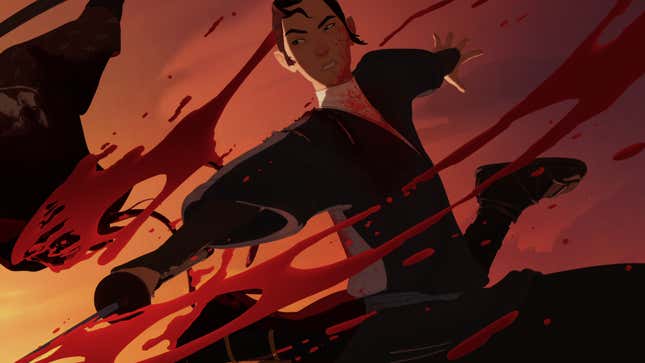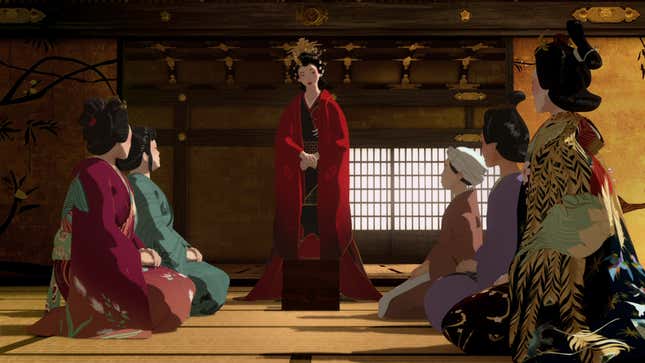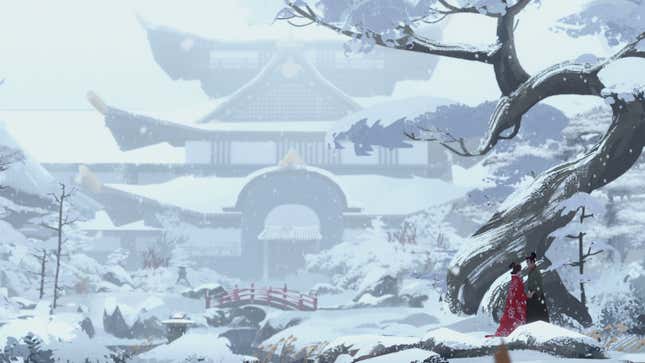Blue Eye Samurai is a remarkable new adult animation series coming out on Netflix, led by the husband-and-wife team of Michael Green (Logan, Blade Runner 2049) and Amber Noizumi. With an all-star voice cast that includes Maya Erskine (Mizu), George Takei (Seki), Masi Oka (Ringo), Cary-Hiroyuki Tagawa (The Swordmaker), Brenda Song (Akemi), Darren Barnet (Taigen), Randall Park (Heiji Shindo), and Kenneth Branagh (Abijah Fowler), Blue Eye Samurai boasts incredible visuals, a tightly paced plot, and deeply wonderful characters.
Mizu is a mixed-race woman at a time when very few white people were in Japan. Raised by a swordmaker, she learned from every different swordsman who came to the forge’s doorstep. After a horrible tragedy, she vows to go after the only four white men in Japan at the time of her birth. The series follows her story of revenge during the Edo period of Japan, highlighting a time of uncertainty and change for the Japanese people.
Advertisement
io9 caught up with Noizumi and Green and discussed some of the more nuanced aspects of the show, including its approach to gender and sex work, and how they took their time with the visuals of the show.
Advertisement
Linda Codega, io9: Were there any historic or folkloric stories that inspired Mizu and the story of this show?
Advertisement
Amber Noizumi: We decided very early on that Mizu would be called ‘onryō’ in an effort to dehumanize her. Or somebody who would see her and ask, “What is this creature? Why does she have blue eyes? What am I looking at here?” We had noticed in a lot of Kabuki masks they would paint blue under their eyes to indicate they were ghostly or dead. We definitely went to the idea that she was an homage to that. She was this revenge demon from Japanese folklore. And the idea that some revenge ghosts develop superhuman strength when they’re wronged. So that was definitely an inspiration for Mizu.
Michael Green: We talked about Yentl as an inspiration all the time–the love triangle, the woman who’s desperate to learn an art forbidden to her.
Advertisement

io9: I definitely saw a couple modern references. I thought there was a Lady Snowblood reference or two in there.
Advertisement
Green: Oh, we can pick those out all day. We love with our whole hearts and there are a lot of things we brought into there. There are plenty of cultural Easter eggs for people to point out. We got background things and needle drops in the first episode, for example.
io9: What steps were put in place to make sure that this remained an authentic story besides authentic Asian casting?
Advertisement
Green: We read as much as we could. You absorb as much you can, but then you also know we’re going to make mistakes, so let’s bring in experts who can correct those mistakes. We hired a researcher, Yukio Lippit of Harvard University. We worked with an expert in food of the Edo period because we knew we were going to have so much of that. We had a calligrapher doing our on-screen writing, Aoi Yamaguchi, who also did our beautiful Blue Eye Samurai kanji that’s part of our key art and title page.
Our production design team went deep on absolutely everything they’re designing. They researched as ritually as they could. We hired a costume designer, Suttirat Larlarb, who is world class. She just goes so deep on every cultural reference of everything. And she and her team excavated things that haven’t been seen in hundreds of years to teach us people wore these things because of what their lives were and to help us understand the day to day—what was it to be a farmer, an artisan, a merchant, and how clothing becomes story, becomes character.
Advertisement
On the animation side, it was Blue Spirit, our incredible animation studio, who knew that clothes had to move a certain way. So much effort was spent on that. How kimonos moved, how you walk in them, how a woman’s foot would walk across the floor when she’s being proper, how a sword is held. Everyone cared so much and it made such a difference.

Advertisement
io9: This story speaks a lot to reversing gender roles and subverting gender expectations in very interesting ways. How did you approach that?
Noizumi: We wanted to be careful about identifying Mizu as any specific gender. Mizu was born a woman but she needs to be a man, and so she lives as a man. She has to reverse her gender. She has to give up that. Then you see a snippet in episode five where she does get to act a bit as a traditional woman. She tries out that life a little bit.
Advertisement
And then you see Akemi who has the best version that a woman can have. She’s the 1% in Japan at the time. But she’s miserable. She has no freedom and she is treated as property. We definitely see a lot of the gender roles in there and basically just how shitty it was to be a woman.
io9: One of the things that I really appreciated about the series was the fact that sex work is incredibly nuanced and wonderfully explored. Can you speak to what went into developing those characters and storylines in a way that avoided the worst of sex worker stereotypes?
Advertisement
Noizumi: There’s a great book called Selling Women that really does a deep exploration into those jobs and the roles of sex workers and in that period of Japan. But ultimately, when Akemi decides to go into the brothels, she realizes that these women have more freedom than she does. And so we explore that idea.
In Japan at that time they didn’t have the same shame about sex that much of the Western culture had. So we are just using sex to explore Japanese culture in the 17th century and what it was to be a woman. I mean Akemi goes into it. She goes into a brothel and she sees what it’s like. And it’s not much worse than her life.
Advertisement
io9: I know that Mizu and Teigen had a great rivalry that builds throughout the season, but I was rooting for Akemi and Mizu to kiss.
Green: Then you are rooting for a second season.
io9: Beautiful.
Green: We want a love triangle.
Noizumi: We’ve got a lot in store.

Advertisement
io9: My last question is about pacing and tension, because a really beautiful part of the series is the fact that even though I know it’s eight episodes, I still felt like Mizu was going to die in every single fight. But we never feel rushed with these characters. And we get this incredibly rich portrayal of all these people. How did you achieve that kind of pacing where there is still all this intense tension?
Green: We spent a lot of effort on pacing and we wanted each episode to feel like an episode. Though a marathon watch can be a wonderful thing, watching one episode a night should be its own short story. Each episode is a full film and each episode delivers its own experience. We made sure to take our time. Television can [operate with a] fear of losing an audience’s attention, and we always felt that by a certain point, people are either watching or not. And there is that sort of pilot trick where people will do beautiful atmospheric shots in the pilot, but then they forget to do them after. We’re like, “Oh, no, no, no, no, no.” Smoke rises and we just linger. People walk across screens slowly and we get beautiful landscape shots. We love that stuff. So a lot of it is just us kind of tickling ourselves.
Advertisement
This interview has been edited for length and clarity.
Blue Eye Samurai will be available to stream November 3 on Netflix.
Want more io9 news? Check out when to expect the latest Marvel, Star Wars, and Star Trek releases, what’s next for the DC Universe on film and TV, and everything you need to know about the future of Doctor Who.
Services Marketplace – Listings, Bookings & Reviews